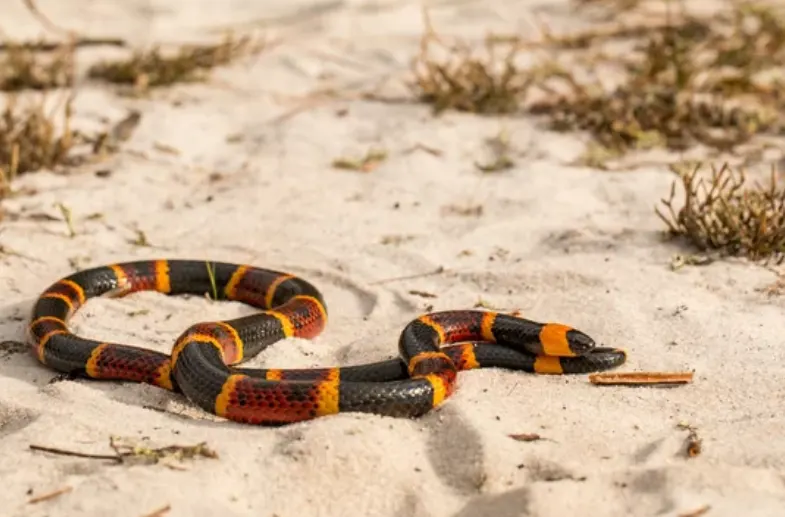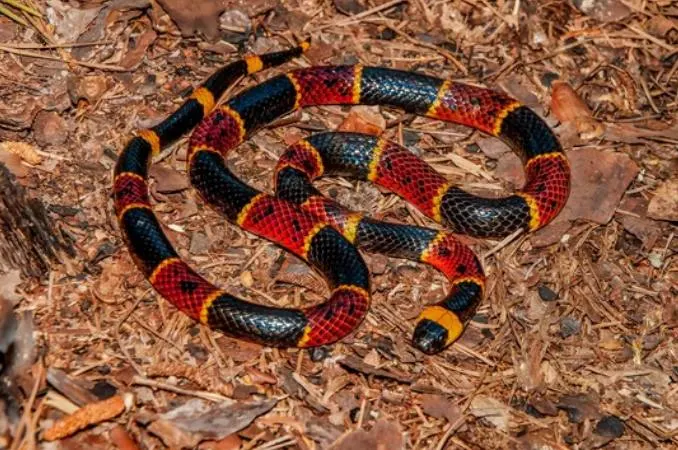Coral snakes, with their vibrant colors and potent venom, have captivated the attention of both snake enthusiasts and the general public for centuries. Found across various parts of the world, including Asia, Central America, and the United States, these elusive creatures are a fascinating blend of beauty and danger. This blog post delves into the captivating world of coral snakes, exploring their unique characteristics, habitat, behavior, and why they are so feared yet revered in the animal kingdom.

Table of Contents
Overview and Classification
Coral snakes are members of the Elapidae family, which includes other notorious snakes like cobras and mambas. With over 80 species worldwide, coral snakes are broadly categorized into Old World and New World species. The Old World coral snakes are found in Asia and Southeast Asia, while the New World coral snakes are native to the Americas, particularly in the southern United States, Central, and South America.
Scientific Classification:
- Kingdom: Animalia
- Phylum: Chordata
- Class: Reptilia
- Order: Squamata
- Family: Elapidae
- Genus: Various (Calliophis, Sinomicrurus, Micrurus, etc.)
Physical Characteristics
Coral snakes are known for their striking color patterns, which typically feature alternating bands of red, yellow (or white), and black. This distinct coloration serves as a warning to potential predators about the snake’s venomous nature. However, the “red touches yellow, kill a fellow” rhyme, often taught to help distinguish coral snakes from non-venomous mimics like kingsnakes, is not always reliable. The coloration and banding patterns can vary significantly among species, particularly between the Old World and New World groups.
Most coral snakes are relatively small, typically measuring between 2 to 4 feet in length. Despite their size, they possess one of the most potent venoms among snakes. Their fangs, though small and not hollow like those of pit vipers, deliver a neurotoxin that can be deadly if left untreated.
Habitat and Distribution
Coral snakes inhabit a wide range of environments, from the dense forests of Asia and the jungles of Central and South America to the arid regions of the southern United States. They are primarily fossorial, meaning they spend much of their time burrowing in the leaf litter or soil, rarely venturing out except during the rainy season or to breed.
In the Americas, coral snakes are commonly found in states like Florida, Texas, and Arizona. These regions provide the ideal conditions for their survival, with plenty of cover and a suitable climate. Old World coral snakes, on the other hand, are distributed across countries like India, Thailand, and Indonesia, where they inhabit forested areas with dense vegetation.
Behavior and Diet
Coral snakes are nocturnal and reclusive, preferring to avoid human contact whenever possible. They are solitary creatures, coming together only to mate. Despite their venomous nature, coral snakes are not aggressive and will typically flee when confronted. However, if threatened or handled, they may bite, delivering their potent venom through a series of chewing motions, as their fangs are not designed to inject venom in a single strike.
The diet of coral snakes mainly consists of other reptiles, particularly smaller snakes. Some species, like the blue Malaysian coral snake, have a specialized diet that includes other venomous snakes, such as pit vipers. They may also consume small mammals, birds, and amphibians, depending on what is available in their environment.
Venom: Potency and Effects
The venom of coral snakes is among the most toxic of all snakes, second only to that of the black mamba. It contains neurotoxins that attack the nervous system, leading to paralysis, respiratory failure, and potentially death if not treated promptly. Despite its potency, coral snake bites are relatively rare due to the snake’s reclusive nature and the inefficiency of its venom delivery system.
Unlike vipers, which have long, hollow fangs that inject venom deeply into their prey, coral snakes have short, fixed fangs with grooves along which the venom travels. This means that to deliver a fatal dose of venom, a coral snake often needs to chew on its prey or attacker. As a result, most bites occur when the snake is handled or accidentally stepped on.
Conservation Status
The conservation status of coral snakes varies by species and region. While many coral snakes are not currently endangered, some species face significant threats from habitat loss and human encroachment. In North Carolina, for instance, the eastern coral snake is listed as endangered due to habitat destruction and declining populations.
Several species are also listed as vulnerable on the IUCN Red List, including the Roatan coral snake (Micrurus ruatanus) and the Oaxacan coral snake (Micrurus ephippifer). Conservation efforts are crucial to preserving these species, particularly in areas where their habitats are under threat from deforestation, urbanization, and agricultural expansion.
Coral Snakes and Humans
Despite their fearsome reputation, coral snakes pose little threat to humans when left undisturbed. Most bites occur when individuals attempt to handle or kill the snake, often out of fear or curiosity. Education and awareness are key to preventing such encounters, as understanding the behavior and habitat of coral snakes can help people avoid unnecessary risks.
In the event of a coral snake bite, immediate medical attention is essential. Antivenom is available for many species, particularly in the United States, where coral snake bites are most common. However, due to the rarity of bites, antivenom production has decreased in recent years, making it even more critical to seek prompt treatment.

Interesting Facts
- Venom Delivery: Unlike most venomous snakes, coral snakes do not have hollow fangs. Instead, they deliver venom through small, grooved fangs that require the snake to chew on its prey.
- Mimicry: Several non-venomous snake species, such as kingsnakes and milk snakes, mimic the coloration of coral snakes to deter predators, a phenomenon known as Batesian mimicry.
- Old World vs. New World: Coral snakes are divided into two major groups based on their geographic distribution. Old World coral snakes are found in Asia and the Middle East, while New World coral snakes are native to the Americas.
- Nocturnal Hunters: Coral snakes are primarily nocturnal, using their keen sense of smell and heat detection to locate prey in the dark.
- Aquatic Adaptations: Some coral snake species, particularly in Asia, are semi-aquatic and have adapted to life in water, with flattened tails that act as paddles.
Coral snakes are a unique and fascinating group of reptiles that combine striking beauty with deadly potential. Their vibrant colors and potent venom have earned them a place in both folklore and scientific study. While they are not as aggressive as some of their venomous relatives, coral snakes should be respected and admired from a distance. Understanding their behavior, habitat, and role in the ecosystem can help reduce the risk of encounters and ensure the continued survival of these remarkable creatures.
- Enchi Ball Python: A Unique and Stunning Morph of Python regius - March 27, 2025
- Emerald Tree Monitor: The Enigmatic Green Guardian of the Rainforest - March 26, 2025
- The Egyptian Cobra (Naja haje): A Fascinating Serpent - March 25, 2025
